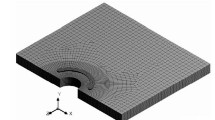In order to simulate the operating fretting-fatigue conditions in cylindrical structural components, we have performed experimental studies on fretting fatigue of cylindrical specimens with clamped concave cylindrical pads of bridge type. Using the known solutions for stress intensity factors in the semi-elliptical cracks growing in cylindrical specimens, we predict the kinetics of propagation of fretting-fatigue cracks according to the two-parameter model described in Part 1. A close correlation of calculated and experimental fretting-fatigue life values is observed for AMg6N alloy for varied experimental fretting conditions (contact load, slip amplitude and friction coefficient). For alloy VT9 we have provided approbation of the technique, which takes into account distribution of the residual stresses in the material subsurface during calculation of stress-strain state and life under fretting-fatigue conditions.




















Similar content being viewed by others
References
A. O. Khotsyanovskii, “Life prediction of titanium and aluminum alloys under fretting fatigue conditions using various crack propagation criteria. Part 1. Experimental and calculation techniques,” Strength Mater., 42, No. 6, 683–704 (2010).
A. E. Giannakopoulos, T. C. Lindley, and S. Suresh, “Aspects of the equivalence between contact mechanics and fracture mechanics: theoretical connections and a life-prediction methodology for fretting fatigue,” Acta Mater., 46, No. 9, 2955–2968 (1998).
A. Otsuka, H. Sugawara, and M. Shomura, “A test method for Mode II fatigue crack growth characteristics of hard metals,” Fatigue Fract. Eng. Mater. Struct., 27, No. 3, 203–212 (2004).
V. T. Troshchenko, G. V. Tsybanev, and A. O. Khotsyanovskii, “Life of steels in fretting fatigue,” Strength Mater., 20, No. 6, 703–709 (1988).
V. T. Troshchenko, G. V. Tsybanev, and A. O. Khotsyanovskii, “Two-parameter model of fretting fatigue crack growth,” Fatigue Fract. Eng. Mater. Struct., 17, No. 1, 15–23 (1994).
A. O. Khotsyanovskii, Life Prediction of Structural Steels and Alloys under Fretting Fatigue for Fatigue Crack Propagation Stage [in Russian], Author’s Abstract of the Candidate Degree Thesis (Tech. Sci.), Kiev (1990).
A. Carpinteri, “Shape change of surface cracks in round bars under cyclic axial loading,” Int. J. Fatigue, 15, 21–26 (1993).
A. Carpinteri and C. Majorana, “Fatigue growth of edge flaws in cylindrical bars,” Strength Mater., 27, No. 1–2, 26–38 (1995).
A. Athanassiadis, J. M. Boissenot, and P. Brevet, “Facteurs d’intensite de contrainte et force d’extension de fissure dans le cas d’une fissure transversale dans un fils cylindrique,” Bull. Liasion Lab. Ch., 105, No. 1, 73–78 (1980).
L. Chambon and B. Journet, “Modelling of fretting fatigue in a fracture-mechanics framework,” Tribology Int., 39, 1120–1226 (2006).
V. A. Vainshtok and I. V. Varfolomeev, “Calculation of weight functions and stress intensity factors for semi-elliptical cracks in a layer,” Mech. Solid Body, No. 2, 132–139 (1988).
Author information
Authors and Affiliations
Additional information
Translated from Problemy Prochnosti, No. 1, pp. 63 – 81, January – February, 2011.
Rights and permissions
About this article
Cite this article
Khotsyanovskii, A.O. Life prediction of titanium and aluminum alloys under fretting fatigue conditions using various crack propagation criteria. Part 2. Application of the technique to cylindrical specimens with semi-elliptical crack and account of the residual stresses. Strength Mater 43, 42–55 (2011). https://doi.org/10.1007/s11223-011-9266-0
Received:
Published:
Issue Date:
DOI: https://doi.org/10.1007/s11223-011-9266-0




